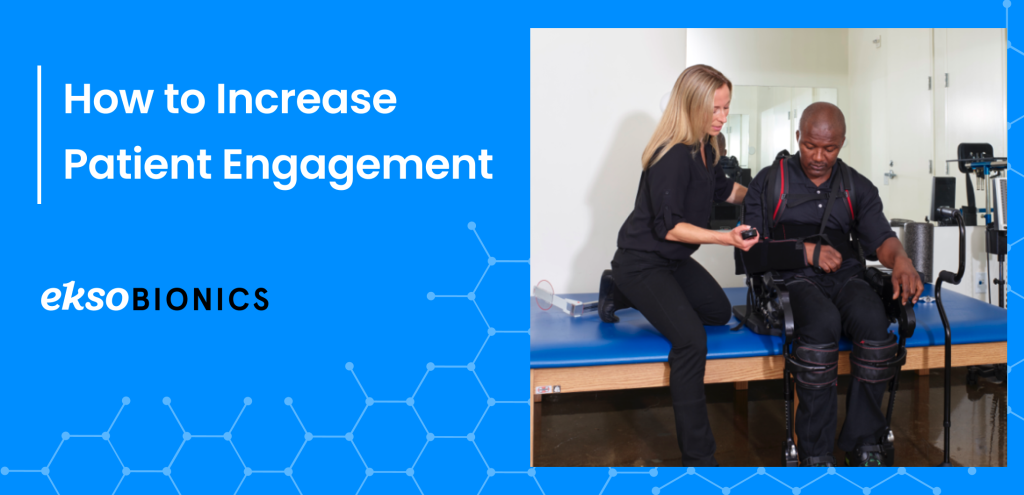According to a survey conducted by NEJM Catalyst Insights Council survey [1], healthcare practitioners believe that only 34% of patients are engaged in the care process. This statistic is worrying, given that a huge part of a patient’s well-being is determined by their interest and participation in their health. Irrespective of the medical innovations and advancements, it takes effort from the patient to generate positive and sustainable outcomes. This can be compromised when patients are not engaged in the care process, hence the need for patient engagement.
Patient engagement can lead to better outcomes and improved long-term health. It can also reduce the cost burden on the healthcare system and reduce preventable readmissions. This article highlights ten efficient strategies you can implement now and their benefits.
What Is Patient Engagement?

Patient engagement is defined as the process where patients are actively interested and proactively participate in their own well-being. When carried out well, it becomes a shared responsibility by all stakeholders in the healthcare process, including the patients, healthcare workers, and administrators. The patient takes a keen interest in their health, healthcare workers involve the patient actively in the healthcare process, and the administrators facilitate the effective collaboration of healthcare professionals and the patient.
Patient engagement provides a platform for health workers to be more transparent and open, which translates into a responsive system. In other definitions of patient engagement, the engagement goes beyond education and decision-sharing. It includes training and financial support as a necessary means of aiding patient participation. This makes it clear that patient engagement isn’t only about getting patients engaged in the process but also inspiring healthcare organizations and workers to play a more active role.
How to Increase Patient Engagement

1. Create Patient Segments
All patients have different needs and diagnoses. Creating patient segments involves clustering all patients with similar conditions and needs within the same group. Creating patient groups can help you as a therapist to better understand patient needs and draw insight into the type of treatment that may work best. It can also help you create targeted strategies that will help you deliver better care to the individual groups. For instance, you can create a segment of patients with upper extremity mobility issues and another group for patients with lower extremity mobility issues instead of clustering them together. This will help patients gain peer support and community with other patients who understand their struggle.
2. Educate Patients
Education is a big part of patient engagement. Consider this; a patient walks into a medical facility for an appointment. They have no idea what’s going on with their body, only that they are experiencing different symptoms, and they are not well. They consult with a doctor and immediately receive a prescription for a medicine they are not familiar with, lifestyle adjustment recommendations they don’t understand, and a “get well soon.” This patient is more likely to disengage in their treatment and give up due to a lack of understanding. A patient with better knowledge of the prescribed medication and recommendations, in comparison, is more likely to follow the recommendations.
The American Journal of Medicine reports that 50% of patients with chronic diseases fail to benefit from treatment as a result of poor compliance which stems from low treatment understanding. [2] Lack of compliance normally leads to more hospitalizations, poor clinical outcomes, and reduced quality of life, making it essential to engage patients in order to increase compliance levels. A 2005 study reported that patients who received education materials were more compliant to treatment compared to those who did not receive educational materials. This resulted in more treatment satisfaction, increased communication with healthcare providers, and better outcomes. [2]
When educating patients, it is important to use clear language that your patients can easily understand. You can use handouts, website portals, and a teach-back method as part of your education strategies.
3. Involve Patients in Decision Making
One of the main areas that patients value in their interaction with physical therapists is shared decision-making. While they may not be vocal about it, research has shown that patients have better treatment outcomes when they are involved in decision-making. [3] I think we can agree that nobody likes being told what to do, but when involved in the decision-making process, we feel seen, heard, and considered. This applies to your patient interactions as well. While you may be the expert in the room, the patient is the expert on their routines, preferences, and body. Involving them in the treatment decisions will help you come up with better solutions that are suited to their individual situations.
A Mayo Clinic study showed that hospital admissions were reduced by 19% when they implemented a patient decision-making program. The researchers reported that the decision-making tool helped provide better care and improved clinical outcomes. [4] You can incorporate shared decision-making in your patient sessions by:
- Educating your patients about available options and how they play out in the patient’s lifestyle.
- Discuss goals and values with your patient.
- Deciding on treatment with your patient.
Before utilizing shared decision-making, it is important to understand your patient’s preference toward shared decision-making and involve them accordingly. You can use available shared decision-making tools like statin choice, PCI choice, or Rheumatoid arthritis choice, among others. Shared decision-making for physical therapists might involve selecting the best therapy exercises together with your patient.
4. Deliver Continuous Care
Patient care doesn’t end when a patient receives their prescription and walks out of your office. Continuous care (ongoing supervision) should be part of your patient encounters until they learn how to take care of themselves in a sustainable and healthy way. According to research, continuous patient care contributes to increased patient satisfaction and decreased hospital visits. It is also associated with an increase in preventative care. This can go a long way, especially for patients who suffer from chronic conditions like diabetes. According to a 2016 study, continuous care was reported to help patients with diabetes reduce their medical costs and health complications. [5]
Continuous care outside of your therapy sessions will help the patient maintain their improvement trajectory and also keep them ready for subsequent therapy sessions.
5. Simplify Medical Information
A major component of patient education (seen above) is simplifying information. Medical information can be complex, especially for people with no medical background. This is one of the biggest obstacles healthcare professionals must overcome when dealing with patient engagement.
It is extremely important to use simple language that the patient and caregiver understands. According to a study done by the National Institute of health, family caregivers deal with more healthcare issues than the patients because they are in charge of administering medication and other treatments. [6] This can be taxing if the caregiver doesn’t understand the information provided by the doctor. This makes it crucial to tailor your communication to the health literacy of your patient/caregiver. Avoid using medical jargon that may be confusing when giving instructions. When teaching your patient, remove as many medical terms as possible, replacing them with common language or explaining what the medical term means.
6.Use Images and Charts When Communicating
Visual aids are one of the amazing tools you can use in your practice in order to simplify information. They are also great as they are more memorable compared to written text. Visual aids can be in the form of images, diagrams, and videos. For instance, when conducting physical therapy, you could show your patient a diagram of the structures within the body and how the therapy treatment will affect them. Many home exercise programs include pictures or videos to help the patient recall what to do at home.
7. Do Not Make Assumptions When Communicating with Patients
It’s easy to assume that patients understand because you already know the information you are sharing with them. However, the concepts you are sharing may be unfamiliar to them. Additionally, their understanding of the information is shaped by their beliefs and backgrounds as opposed to science. This makes it essential to make sure that they accurately understand what you share with them from a scientific perspective.
8. Start Engagement Before a Patient Arrives
Gone are the days when you had to wait for patients to walk through the door in order to start engaging with them. With the advancement of technology, you can begin engaging with your patient before their appointment. You can use pre-visit tactics like appointment reminders and intake forms to start engaging with your patients before consultations. This will help them prepare accordingly and help you understand critical information about your patient that can help you prepare for the consultation session.
9. Stay Engaged Throughout Aftercare
Aftercare is follow-up care given to a patient after hospitalization or after a major procedure. Aftercare is an essential period for patients because this is the period when treatment really takes place. However, most patients ignore and misunderstand aftercare instructions which can lead to more complications and readmittance. According to one study, non-adherence to aftercare instructions can be up to 70%, especially if they are complex or demand a lifestyle change. [7] This normally leads to poor outcomes and even death in some cases. It is reported that there are approximately 125,000 deaths/year resulting from complications encountered as a result of non-adherence.
This makes it important for healthcare providers to simplify aftercare instructions and to follow up to ensure that patients stick to the recommended treatment. This can be through scheduled phone calls, emails, or texts.
10. Use Preferred Patient Channels
When improving patient engagement, it is recommended that you meet patients where they are, and this involves making an active commitment to reach out to them either before or after treatment. In order to do this effectively, it is recommended that you use their preferred communication channel. Potential channels you can use include: Whatsapp, email, phone, text, zoom, and patient portals. The list is endless here, but the most important thing is using a channel that the patient is comfortable engaging in.
Why Is Patient Engagement Important?

The importance of patient engagement cannot be overlooked. It is critical in improving healthcare standards, lowering cost, reducing wastage and improving patient outcomes, and well-being.
1. Improved Outcomes
One key benefit of patient engagement is improved patient outcomes. Active participation by patients increases their chances of adherence to treatment which equally contributes to better health. As pointed out above, non-adherence affects treatment outcomes, and patient engagement is the only way to reduce that.
2. Higher Quality Care
A quality gap exists in the healthcare system where healthcare processes differ from the outcomes achieved and observed. Patient engagement can help improve the quality of care, thereby closing this gap.
3. Improved Patient Satisfaction and Retention
Patients want to be seen, heard, and acknowledged. Engagement makes them more engaged in the treatment journey, resulting in satisfaction with the service they receive. This contributes to increased loyalty which can help you retain patients for longer.
4. Improves Patient’s Long-Term Health and Well-Being
When patients are engaged in their health, they are more likely to make better decisions that affect their health and well-being positively. When patients engage and become active, they are also more likely to detect disease symptoms early and seek treatment without putting it off (before it becomes a big issue).
5. Reduces Waste
More often than not, patients receive aftercare instructions in the form of flyers and pamphlets, but very few read them. This results in wastage. However, when similar materials are presented to engaged patients, they are used as expected, resulting in productive use, thereby reducing waste.
6. Reduces Potentially Preventable Readmissions (PPR)
According to this study, unengaged patients have higher chances of readmission due to failure to follow aftercare instructions. This results in complications that may lead to readmission and sometimes death. This can be reduced by engaging them throughout the process with the strategies we mentioned earlier.
7. Lower Costs
Unengaged patients tend to have higher no-show rates, delayed care incidents, and unmet medical needs, which can be taxing on the healthcare system. Medication non-adherence is also very expensive and increases the cost burden on health care systems.
According to research, patient engagement may lead to reduced costs within the healthcare system. The New England Healthcare Institute reported that the total estimated savings of this endeavor amount to over $290 billion in the U.S. Engaging patients also leads to better recovery, reduced no-show rate, and fewer visits. According to this 2018 study, non-adherence costs are avoidable, and one way to ensure this is through patient engagement. [8]
Conclusion

Incorporating the patient engagement strategies discussed here will increase treatment effectiveness, leading to higher patient satisfaction. Inadvertently leading to higher patient retention rates and more referrals to your practice. It can also help increase therapy completion rates.
While patient participation is vital in improving clinical effectiveness, it is important to remember that patient engagement goes both ways. It requires you to put in the effort during a patient visit and requires patients to put in more, if not the same, effort in contributing to their own well-being.
References:
1. Patient Engagement Survey: Improved Engagement Leads to Better Outcomes, but Better Tools Are Needed
2. Approaches to Patient Education: Emphasizing the Long-Term Value of Compliance and Persistence
3. Efficacy of Patient Activation Interventions With or Without Financial Incentives to Promote Prescribing of Thiazides and Hypertension Control: A Randomized Clinical Trial | Cardiology | JAMA Network Open
4. Shared Decision-Making Reduces Cardiac Admissions from the ED
5. Shared decision making in patients with low risk chest pain: prospective randomized pragmatic trial | The BMJ
6. Family Caregiving Roles and Impacts – Families Caring for an Aging America – NCBI Bookshelf
7. The challenge of patient adherence – PMC
8.Economic impact of medication non-adherence by disease groups: a systematic review – PMC
